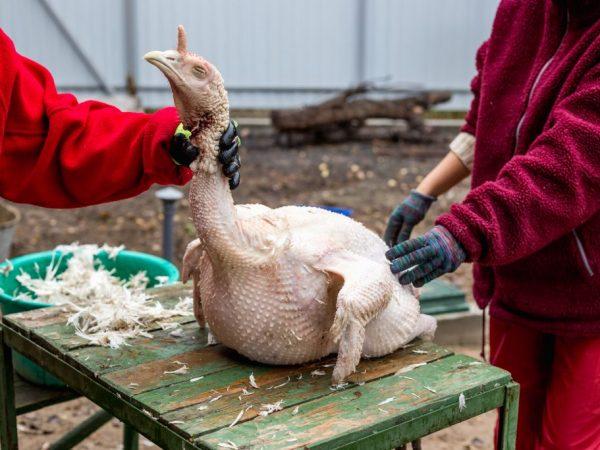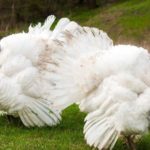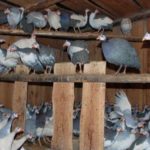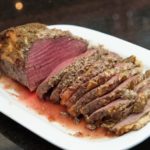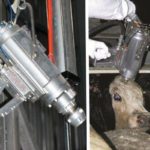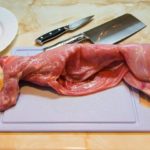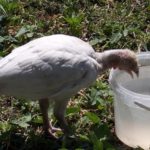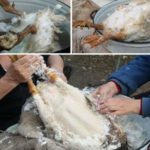Description: The ultimate goal of raising turkeys on a farmstead is to obtain delicious meat, therefore, the bird must be slaughtered. In this not the simplest process, there are nuances that indicate how to slaughter a turkey yourself at home, carry out subsequent plucking and cutting of the carcass in the most delicate way to preserve the taste and give it an appetizing appearance.
At what age should a bird be slaughtered?
The correct timing of slaughter is important to obtain fully “ripe” meat.Poultry farmers consider it correct to go under the knife only after the chicks have reached sexual maturity and gain weight only from an increase in fat and muscle mass. This usually happens 8-9 months after hatching from the eggs, by which time the turkey poults already weigh about 12 kg or more.
Broiler breeds (Big-6, white broad-breasted and others) reach such parameters earlier - by six months or even by 4 months of age (120 days).
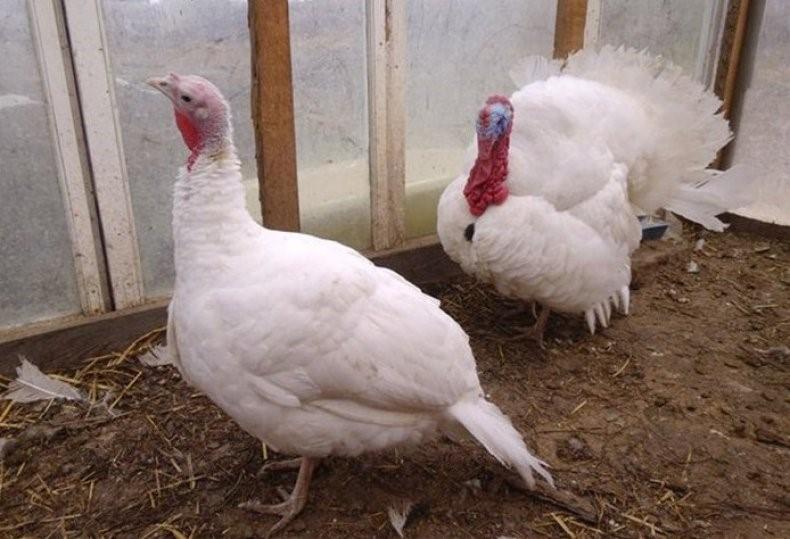
The meat of an adult bird loses its tenderness and softness, but remains dietary, and too little of it comes out of too young chicks.
An important note: slaughter should be carried out before the birds begin to molt, otherwise it will be almost impossible to completely get rid of the feathers.
Preparing the bird for the start of the process
To carry out the slaughter procedure as quickly, easily and efficiently as possible, it is necessary to carefully prepare the bird. To do this, selected livestock are placed on a daily starvation diet in dark pens. Fasting is necessary to ensure that the carcasses are stored for a long time, otherwise the unprepared bird will turn blue in the area of the crop and tail on the 3rd day, and the fat will turn green.
You should leave free access to water in which to stir a 2% solution of Glauber's salt (can be replaced with table salt) for better bowel movements. It should be started 15-20 hours before slaughter.
Pre-slaughter pens must be kept clean, removing leftover feed and droppings in a timely manner so that the birds do not eat them.
Turkey slaughter methods
There are several ways to slaughter a turkey at home, but the main condition for proper slaughter of a bird is to completely and as quickly as possible bleed the carcass (if this is not achieved, the meat will quickly deteriorate due to bacteria, and the presentation of the turkey will also suffer). The most popular methods of turkey slaughter are external and internal slaughter.
External slaughter
The easiest way is to chop off the head of an immobilized turkey lying on a wooden block. Cutting off the head with an ax is used mainly during immediate subsequent processing of the carcass, since the meat comes into contact with dirty surfaces from which bacteria can penetrate. This method is also used for slaughter large or old turkeys.
Among poultry breeders, the most common external method of slaughtering turkeys is:
- the bird is placed in a device (cone) or simply hung upside down;
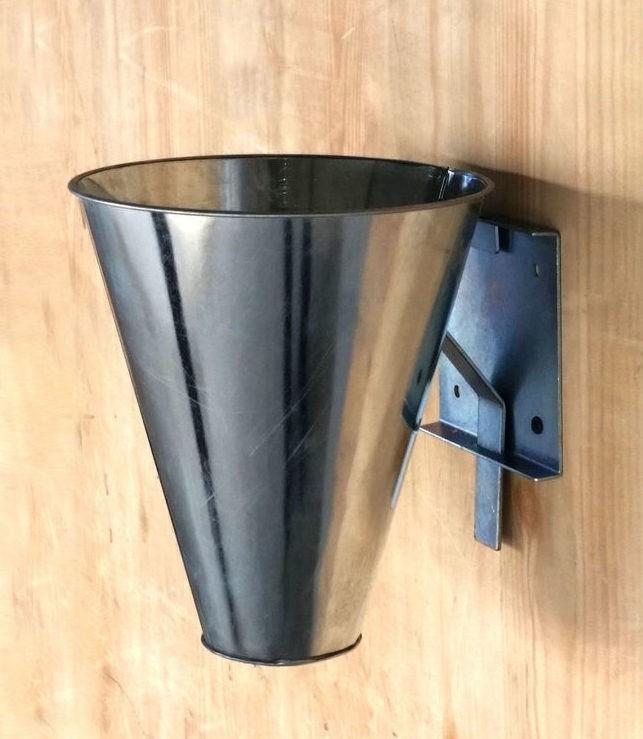
- stunned;
- on the left side of the throat, the facial artery and jugular vein are cut (2.5 cm below the ear) in length by 0.15-0.2 cm;
- the bird dies as a result of rapid blood loss;
- the turkey's wings are fixed in an open form.
This method is cleaner than chopping the head with an axe, but pathogens can also enter open wounds on the neck.
Internal slaughter
This is the most difficult, but the cleanest way to obtain turkey meat, it allows you to ensure cleanliness and hygiene and preserve the product for a long time. The “slang” name for internal slaughter is “into the cleft.”
The bottom line is that a knife (or a special instrument such as scissors) is inserted into the throat of a stunned bird through a wide-open beak as deep as possible and the blood vessels located on the left and right above the tongue are cut.
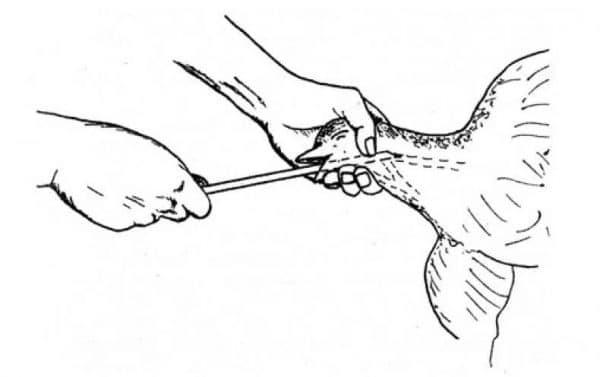
It is necessary to inject the tip of the knife directly into the cerebellum of the bird (from the bottom of the head), which will relax its muscles and make it easier to pluck. The carcass should hang upside down with its wings wide open, just as with external slaughter, while the blood flows straight from the throat and does not stain the plumage, which can then be used for household purposes. A significant disadvantage of the split slaughter method is its complexity: an inexperienced slaughterer does not always find the veins the first time or cannot cut them, as a result of which the carcass becomes saturated with blood.
How to pluck a bird carcass
In this process, experience and a certain skill are important. The trick to properly plucking turkeys is to process the female carcass after it has completely cooled down, and the male carcass while still warm. If the slaughter poultry population is small, the operation to rid the carcasses of feathers is carried out manually, but if there are a lot of dead turkeys, it is more convenient to purchase a special feather removal machine with a number of different attachments.
There are several manual plucking methods:
- dry;
- wet;
- ironing
The dry method is used when feather raw materials are used to fill pillows, blankets and feather beds. The material remains dry, first the flight feathers are removed, then the tail feathers and down.
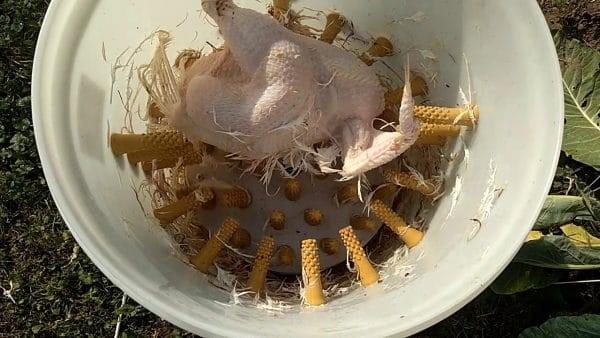
With the wet method, at the first stage, the carcasses are immersed in hot (but not higher than 65 degrees) water for about a minute, after which they begin plucking.It is recommended to perform this operation as quickly as possible, otherwise it will be very difficult to get rid of the flight feathers.
To easily remove feathers from turkeys, you can also use an iron in steam mode, after straightening the feathers with a pump tucked under the skin. By stroking the carcass through a damp cloth, you can effortlessly remove even the coarsest feathers.
The remaining “stumps” are eliminated with a small knife or tweezers, sharply pulling them out one by one from the skin.
Gutting a turkey
The next step after plucking turkeys is gutting the carcass, which is carried out on a covered table. You can carry out complete or incomplete evisceration. In the first case, the internal organs are removed from the turkey, the neck and limbs are separated - this meat is stored longer. If the washed innards are placed back inside the carcass, this is incomplete evisceration; such turkey meat is stored for no more than 3-4 days.
The intestines, crop and esophagus are removed using a special cutting fork. After this, the heart, spleen, kidneys and liver are pulled out, and the cloaca is cut out. For food purposes, the stomach, heart and liver are left after slaughter.
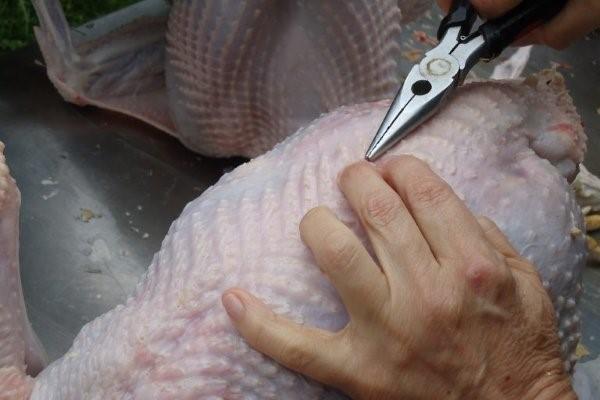
When processing a turkey, it is very important to leave the intestines and spleen intact so that the meat does not become saturated with their contents. When semi-gutting turkeys, only the intestines are removed, all other organs are washed and left in place, and the carcass is cooled.
Cutting instructions for beginners
The cutting begins with the removal of the head and neck bones, leaving one third of the skin. The legs are cut off to the knees, and the wings to the elbows.
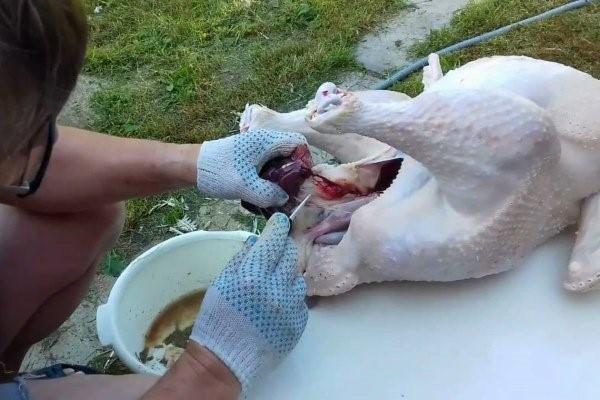
The skin is cut along the ligaments at the junction of the thighs and body of the bird.After removing the entrails, the carcass is cut into pieces or cut with special poultry scissors. The stomach is divided lengthwise and the inner layer is removed.
Ultimately, after cutting up a turkey carcass, the poultry farmer will have:
- wings;
- hips;
- sternum;
- back;
- legs.
Brief video instructions on YouTube:
If you plan to sell or cook a whole turkey carcass, detailed cutting is not required. The main condition for obtaining dietary and tasty meat is to strictly follow the instructions of experienced poultry breeders.

